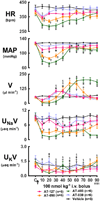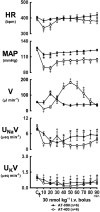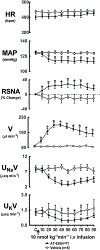Cardiovascular and renal effects of novel nonpeptide nociceptin opioid peptide receptor agonists
- PMID: 34705263
- PMCID: PMC8716424
- DOI: 10.1111/bph.15717
Cardiovascular and renal effects of novel nonpeptide nociceptin opioid peptide receptor agonists
Abstract
Background and purpose: Partial agonists of the nociceptin opioid peptide (NOP) receptor have potential therapeutic use as antihypertensive and water diuretics (aquaretics). To date, peptide NOP receptor ligands have failed to progress in clinical trials due to poor pharmacokinetics and adverse effects. Nonpeptide, small-molecule NOP receptor ligands may be more suitable as therapeutic agents. This study investigated the cardiovascular and renal responses produced by the novel nonpeptide NOP agonists AT-403, AT-090, AT-127, and AT-039.
Experimental approach: Changes in mean arterial pressure (MAP), heart rate (HR), renal excretory function and occurrence of sedation and hyperphagia were determined before and after i.v. bolus injection or infusion of the NOP agonists in conscious Sprague-Dawley rats. Additional studies involving (i) measurement of renal sympathetic nerve activity (RSNA) and (ii) renal denervation were conducted to investigate the role of the renal nerves in the cardiorenal responses to AT-039.
Key results: Bolus i.v. injection of AT-403, AT-090, AT-127 and AT-039 produced significant decreases in MAP and HR and a sodium-sparing diuresis. AT-403, AT-090, and AT-127, but not AT-039, induced sedation and hyperphagia at all doses tested. Infusion i.v. of AT-039 produced hypotension and aquaresis without adverse central nervous system effects or change in HR, responses that were also observed in renal denervated rats.
Conclusions and implications: Nonpeptide NOP agonists decrease blood pressure and produce aquaresis in conscious rodents. Due to lack of sedation and hyperphagia, AT-039 represents a novel NOP agonist that may be useful for treatment of hypertension and/or volume overload/hyponatraemic states.
© 2021 The British Pharmacological Society.
Conflict of interest statement
Figures







Similar articles
-
Functional selectivity of nociceptin/orphanin FQ peptide receptor partial agonists on cardiovascular and renal function.J Pharmacol Exp Ther. 2005 Aug;314(2):643-51. doi: 10.1124/jpet.104.082768. Epub 2005 Apr 26. J Pharmacol Exp Ther. 2005. PMID: 15855356
-
Nociceptin/Orphanin FQ Peptide Receptor-Related Ligands as Novel Analgesics.Curr Top Med Chem. 2020;20(31):2878-2888. doi: 10.2174/1568026620666200508082615. Curr Top Med Chem. 2020. PMID: 32384033 Free PMC article. Review.
-
The therapeutic potential of nociceptin/orphanin FQ receptor agonists as analgesics without abuse liability.ACS Chem Neurosci. 2013 Feb 20;4(2):214-24. doi: 10.1021/cn300124f. Epub 2012 Nov 6. ACS Chem Neurosci. 2013. PMID: 23421672 Free PMC article. Review.
-
The biology of Nociceptin/Orphanin FQ (N/OFQ) related to obesity, stress, anxiety, mood, and drug dependence.Pharmacol Ther. 2014 Mar;141(3):283-99. doi: 10.1016/j.pharmthera.2013.10.011. Epub 2013 Nov 1. Pharmacol Ther. 2014. PMID: 24189487 Free PMC article. Review.
-
Chronic high-NaCl intake prolongs the cardiorenal responses to central N/OFQ and produces regional changes in the endogenous brain NOP receptor system.Am J Physiol Regul Integr Comp Physiol. 2009 Feb;296(2):R280-8. doi: 10.1152/ajpregu.00096.2008. Epub 2008 Nov 5. Am J Physiol Regul Integr Comp Physiol. 2009. PMID: 18987291 Free PMC article.
Cited by
-
Drug repurposing opportunities for chronic kidney disease.iScience. 2024 May 10;27(6):109953. doi: 10.1016/j.isci.2024.109953. eCollection 2024 Jun 21. iScience. 2024. PMID: 38947510 Free PMC article.
References
-
- Alexander SP, Christopoulos A, Davenport AP, Kelly E, Mathie A, Peters JA, Veale EL, Armstrong JF, Faccenda E, Harding SD, et al., (2021) THE CONCISE GUIDE TO PHARMACOLOGY 2021/22: G protein-coupled receptors. British Journal of Pharmacology, 178, Suppl 1:S27–S156. doi: 10.1111/bph.15538. - DOI - PubMed
-
- Asth L, Ruzza C, Malfacini D, Medeiros I, Guerrini R, Zaveri NT, Gavioli EC & Calo' G (2016) Beta-arrestin 2 rather than G protein efficacy determines the anxiolytic-versus antidepressant-like effects of nociceptin/orphanin FQ receptor ligands. Neuropharmacology, 105, 434–442. doi: 10.1016/j.neuropharm. - DOI - PMC - PubMed
-
- Curtis MJ, Alexander S, Cirino G, Docherty JR, George CH, Giembycz MA, Hoyer D, Insel PA, Izzo AA, MacEwan DJ, Sobey CG, Stanford SC, Teixeira MM, Wonnacot S, & Ahluwalia A (2018). Experimental design and analysis and their reporting II: updated and simplified guidance for authors and peer reviewers. British Journal of Pharmacology, 175(7), 987–993. - PMC - PubMed
-
- DiBona GF, & Sawin LL (1983). Renal nerves in renal adaptation to dietary sodium restriction. American Journal of Physiology, 245(3), F322–F328. - PubMed
Publication types
MeSH terms
Substances
Grants and funding
LinkOut - more resources
Full Text Sources

